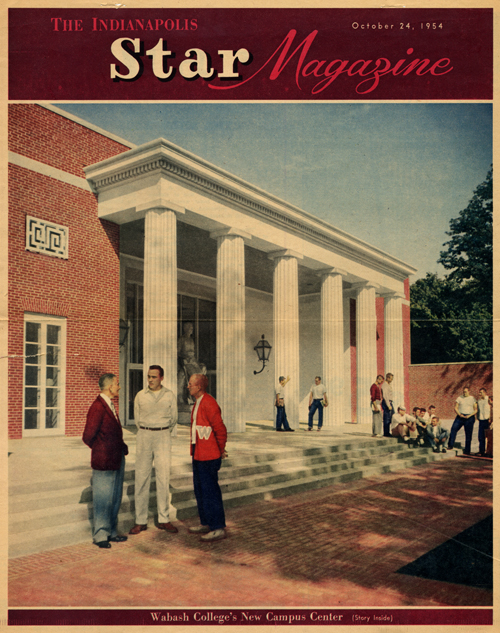I have been thinking about the Sparks Center a lot lately. But before it was the Sparks Center, it was the Campus Center. When it opened in 1954 the Campus Center offered bowling in what is now the Little Giant Room and pool tables in what is now the Bookstore. This cover from the Indianapolis Star Magazine is from October of 1954. President Frank Hugh Sparks is in the foreground chatting with a couple of students.
One of the most interesting bits of history connected to this building is its architect. Designed by Eric Gugler, a nationally prominent architect, the Campus Center made quite a splash among the students. Some students enjoyed the new luxuries but not everyone on campus appreciated the new building. Many students and some members of the faculty felt it was far too fancy for “Old Wabash”.
Gugler created a duplicate of this building for the United States WWII Memorial Cemetery in Italy. The memorial building does not have the mezzanine level, nor is it of brick. However, it does have the same number of pillars and the “look-through” feature of our Campus Center. Here is a photo of that building…
Gugler created much of the look of our campus today as the architect of the following buildings: Waugh Hall, Campus (Sparks) Center, Wolcott and Morris Dormitories, Lilly Library, parts of the Allen Center, and Baxter Hall.
Gugler had many high profile architectural commissions. He designed the Teddy Roosevelt memorial, a 91 acre park on an island in the Potomac River, in Washington, D.C. He did a building for the New York World’s Fair of 1939. He was active in the earliest preservation efforts and was a founding member of the National Trust for Historic Preservation.
Perhaps his crowning achievement was the rebuilding of the West Wing. From the White House Historical Association’s webpage:
http://www.whitehousehistory.org/05/subs/05_f15.html
“With the expansion of the staff in the 1930s, Franklin D. Roosevelt requested additional space, and the [west] wing was completely rebuilt under the eye of Eric Gugler. He built a second story, excavated a larger basement for staff and support services, and moved the oval office from the south to its present location in the southeast corner, adjacent to the Rose Garden. The wing, doubled in size, has not seen further exterior alterations except for a small porte cochere on the north side, constructed in 1969.”
Gugler’s papers are a part of the White House Collection and include, “… details on the 1934 West Wing expansion, landscape plans, collecting art for the West Wing under the Public Works Art Project, White House advisory committee work in the Red Room, Green Room, and Blue Room, designs of the Steinway grand piano, and the State Dining Room mantel inscription. These are supplemented by his memoir of these projects along with a few signed letters from President and Mrs. Roosevelt, memorandums, photographs, drawings, textile samples, and related newspaper clippings.” The papers are further described here, “The Gugler Papers illuminate a significant White House architectural project and offer insight into President and Mrs. Roosevelt’s involvement with White House spaces and environments.”
Gugler makes a fascinating, and direct, connection between Wabash and the West Wing.
Beth Swift Archivist Wabash College

2 comments on “Sparks Center”
dear beth,
this was a lovely article. i enjoyed it so much.
thank you,
renie
Dear Renie,
I am so glad you enjoyed it. I love the full color picture!
Your grandfather (Frank Hugh Sparks)really changed the face of this campus…I am delighted to share that story.
Beth
Comments are closed.